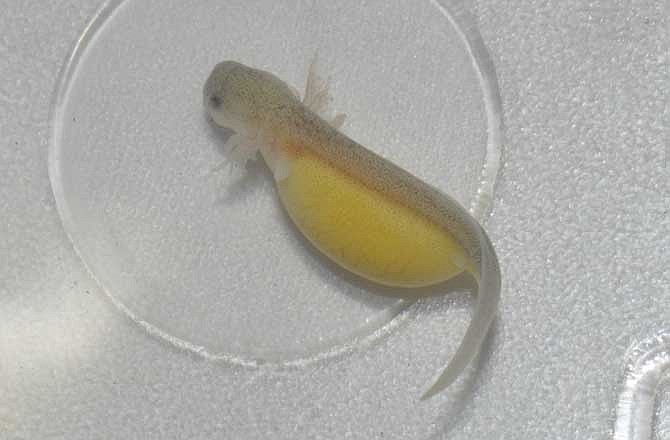By JIM SALTER
Associated Press
ST. LOUIS (AP) - The rare Ozark hellbender, an endangered amphibian found only in a few Missouri and Arkansas counties, has been successfully bred in captivity for the first time, offering new hope for the animal's survival, scientists involved in the breeding effort said Wednesday.
Officials with the St. Louis Zoo and Missouri Department of Conservation said the first captivity-bred hellbender hatched on Nov. 15 at the zoo. Sixty-two more soon followed, and an additional 120 eggs are expected to hatch within the next week.
"We don't want this animal disappearing, and today's announcement makes us believe we have a way to save the hellbender," said Jeff Briggler, a herpetologist for the Missouri Department of Conservation.
The breeding is the result of a decade-long collaboration between the zoo and the state conservation department.
Rivers in the Ozarks region of southern Missouri and northern Arkansas once supported up to 8,000 Ozark hellbenders, but experts believe fewer than 600 now exist in the wild. The hellbender was added to the federal endangered species list in October.
The Ozark hellbender can grow up to 2 feet long - making it among the largest species of salamanders in North America. It is commonly known by a variety of nicknames - snot otter, alligator of the mountains, devil dog, mud-devil, walking catfish.
The hellbender is rarely seen because it stays hidden in the water with its brown skin with black splotches. It has a slippery, flattened body that easily fits into crevices and allows it to cling to river bottoms and move through strong currents. It also has numerous folds of skin on its sides, allowing increased oxygen absorption from the water.
The U.S. Fish and Wildlife Service said the main threat to the hellbender is damage to its habitat from mining, animal operations and fertilizer runoff. Briggler also cited the illegal capture and overseas sale of the hellbender for pets.
In fact, amphibians are in decline worldwide because of habitat loss and environmental degradation, prompting efforts to breed them in captivity to increase their numbers. Across the state in Missouri, the Kansas City Zoo has a breeding program for endangered Wyoming toads, which became extinct in the wild in 1994.
The plight of the hellbender prompted development of the Ron Goellner Center for Hellbender Conservation at the St. Louis Zoo. The eggs are the result of breeding of two wild-bred parents. The male has been at the zoo for two years. The female arrived in September.
The hatched eggs are maintained in climate-controlled trays in the zoo's Herpetarium. Zoo officials say that for the first 45-60 days after emerging, the larvae will retain the yolk sack for nutrients and move very little. They won't develop legs or external gills until they reach 18 months to 2 years of age, and won't reach their full length until ages 5-8.
The captive-bred larvae can be released into their natural habitat at maturity.
Because the hellbender requires cool, clean running water to thrive, it serves as a barometer of the overall health of its ecosystem, said Jeff Ettling, curator of herpetology and aquatics at the zoo.
"Capillaries near the surface of the hellbender's skin absorb oxygen directly from the water - as well as hormones, heavy metals and pesticides," Ettling said. "If there is something in the water that is causing the hellbender population to decline, it can also be affecting the citizens who call the area home."
The breeding program at the zoo has roots to 2001, when a group of scientists in Missouri and Arkansas began a number of projects to reverse the decline of the hellbender - egg searches, disease sampling, behavioral studies.
In 2004, funding from the Missouri conservation department, the Fish and Wildlife Service, private donors and the zoo paid for development of the breeding program in St. Louis.

